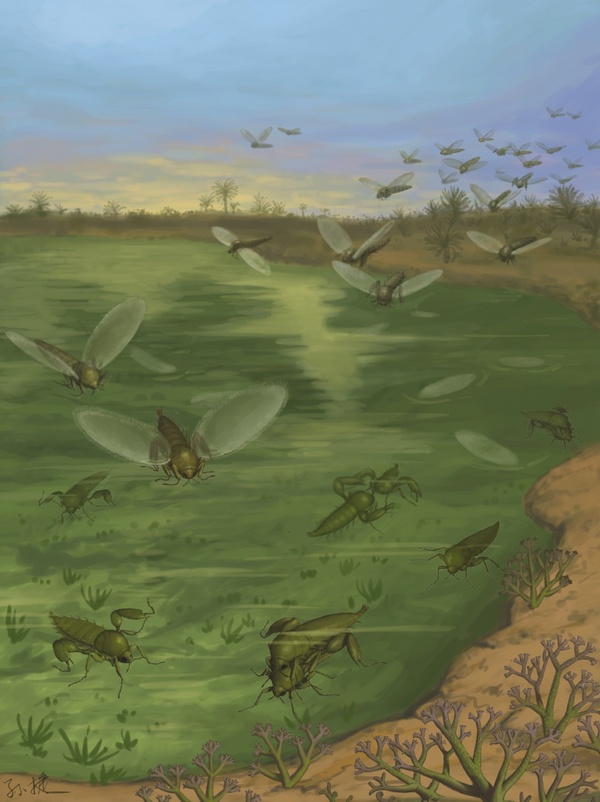It has been known for long in a famous book <Evolution of the Insects> that the most puzzling fossil insects are Saurophthirus and Strashila. On March 8th of 2012, Professor HUANG Diying from the Nanjing Institute of Geology and Palaeontology, Chinese Academy of Sciences reported the diverse transitional giant fleas from Mesozoic of China in Nature, indicating that Saurophthirus is in fact a Cretaceous specialized flea.
However, Strashila still remains an enigma. Strashila was originally reported in 1992 by a Russian palaeontologist. Some scholars believe that it greatly differs from the all known insects and it cannot be placed in any insect orders, while some even establish a new order to accommodate it, suggesting it is an ectoparasite on pterosaurs, or on feathered dinosaurs by some authors. The chelate hind legs were thought to be used for grasping the roots of dinosaur feathers.
On February 20th of 2013, HUANG Diying and his group published an online paper titled “Amphibious flies and paedomorphism in the Jurassic period” in Nature. Based on 13 new specimens of Strashila discovered from the Middle Jurassic Jiulongshan Formation (approximately 165 million years) at Daohugou, Ningcheng County, Inner Mongolia, they put forward new interpretations on these insects, eventually solving the long-standing puzzling scientific problem. The newly found female individuals are totally different from the male: the hind legs of the former are not chelate, and the abdomen lacks lateral appendages, resembling a normal wingless fly and lacking the features of an ectoparasite. More importantly, a male individual has a large and broad forewing, which is evidently not a trait of ectoparasite. Therefore, Strashila are obviously by no means ectoparasites.
Based on detailed morphological studies, Huang et al. suggest that, like the modern house flies and mosquitoes, Strashila is a member of Diptera, a relative of a primitive small group − Nymphomyiidae. Even though Strashila shares some characters with Nymphomyiidae, the males bearing very large wings, chelate hind legs and paired abdominal lateral appendages appear very different from modern nymphomyiids. A modern nymphomyiid, Nymphomyia walkeri, has a similar wing venation as that of Strashila. More interestingly, it has analogous lateral appendages on abdomen which is only found in males. N. walkeri has a special life habit: they mated beneath the water after emergence, shed their wings. For years only wingless individuals of N. walkeri are known, and they usually live in water, despite they can fly. Interestingly, they die in copula beneath the water. Probably like the modern nymphomyiids, after emergence and short-time flight, Strashila shed their wings andmated beneath the water. Thus, the winged Strashila are extremely rare. The mouthparts of Strashila are vestigial, suggesting that the adults do not feed and have an ephemeral life history. The chelate hind legs of males are probably sexually dimorphicused in male-male competition.
The biological function of abdominal lateral lobes of N. walkeri remains unknown. Huang et al. indicate that Strashila has evident paedomorphism−the lateral lobes on abdomens are actually vestigial gills, and it represents the unique example of neoteny of fossil insects.
Diying Huang*, André Nel, Chenyang Cai, Qibin Lin & Michael S. Engle, 2013: AmphibiousfliesandpaedomorphismintheJurassic period. Nature, DOI: 10.1038/nature11898.

Ecological Reconstruction
